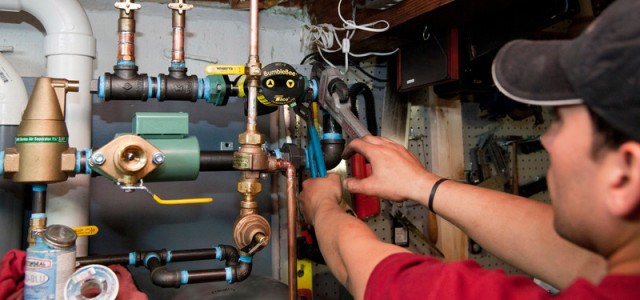 This blog post is part 2 from homeowner Chris in CT about his brand new heating system. In part 1 (which you can read here), Chris had questions about the new FuelMizer installed and this post has questions regarding the Taco BumbleBee circulator, HEC-2.
This blog post is part 2 from homeowner Chris in CT about his brand new heating system. In part 1 (which you can read here), Chris had questions about the new FuelMizer installed and this post has questions regarding the Taco BumbleBee circulator, HEC-2.
1) I understand the BumbleBee comes from the factory with Delta T mode as default. Is this mode ‘locked’ into the circulator from the factory? In other words, if we have a power surge for blackout, will I need to redo any programming?
A: Chris, the BumbleBee circulator default setting is in the Delta T mode and the Delta T temperature is also defaulted to 20 degrees F. The Delta T setting is based upon the heat emitters that you have, if it is finned tube baseboard, this setting is perfect. It is adjustable based upon the type of heat installed in the home from 5 to 50 degrees. Do not worry about having to reprogram the BumbleBee in the event of a power outage. The 120 volt power disconnects from the circulator everytime the need for heat stops from the SR switching relay.
The other modes of the the BumbleBee are Constant Power and Setpoint. Constant Power lets you adjust it to one of 4 fixed speeds (like for an Indirect hot water tank where varying the speed does not help you get hot water but hinder it). Setpoint uses just one sensor on the supply side and it will maintain that water temperature by varying the speed of the circulator if you were using say an injection pumping system. To see how to change the operation look here or here.
2) My HVAC crew left the Delta T temperature at the default 20 degree temp differential. Do you feel this is good to start with? Should I/they bother tinkering with it given my equipment, house and locale (CT)?
A: Good to go, I would leave this setting where it is. 20 degrees F is best for a finned tube baseboard application based upon the majority of baseboard manufacturers. If this was a radiant floor system, you could set the Delta T to 10 degrees and if it was a radiator system like panel rads or cast iron rads, then 30 degrees is a good Delta T for optimum comfort and economy of operation.
3) OK, one more question and then I’m done! 🙂 My last question has to do with sensors. Between the BumbleBee and FuelMizer, there are 2 sensors on the supply side and 1 on the return side. The team was good in properly wrapping the sensors with pipe foam (insulation). I just want to make sure the crew used the correct sensors on the right equipment.
a) On the supply side, the Taco 9300-2051 sensor was used for the Fuelmizer, with the 9300-2044 sensor was used for the BumbleBee (also supply side).
b) On the return side, the 9300-2051 sensor was used for the BumbleBee.
When I saw the different part numbers I got a little concerned, and I think the Fuelmizer instructions advise the 9300-2044 sensor should be used. Should I change the wiring around or leave things as is?
A: All of the sensors are identical in operation and scale. They are thermistors and the resistance through the sensor changes as the temperature it is reading changes. The different part numbers represent different lengths of wire attached to the thermistor. Taco designs all of the electronics that need a sensor to the same thermistor scale so that they can be interchangeable not matter what the component is.
Thanks for your time in answering these questions for a home owner who wants to understand the system that was just installed! 🙂 It’s terrific that you guys are right in Rhode Island and even better that Taco is really thinking about ‘green’ equipment that will move us forward in saving energy/fuel.
A: Enjoy your new system, it sounds and looks like your installers did an outstanding job!!
Thanks everyone who has asked questions to share on Ask Dave! this past year. Remember to keep ’em coming and I look forward to seeing you out there in 2014!
Enjoy!

